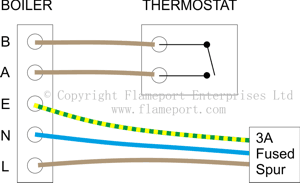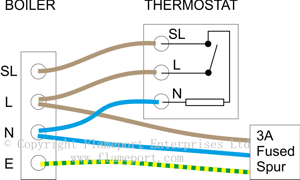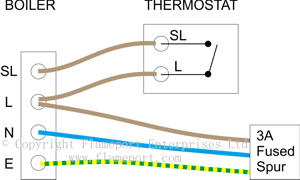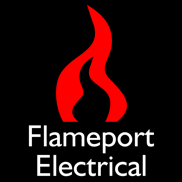Combination Boilers - Thermostats
All combination boilers should have a room thermostat fitted. Without one, there will be no way for the air temperature to be controlled.
Volt free terminals
 Some boilers have volt-free terminals. As the name suggests, these are not connected to any power source, nor must any power be applied to them. In the diagram, these terminals are labelled A and B, however boiler manufacturers may have used alternative markings
Some boilers have volt-free terminals. As the name suggests, these are not connected to any power source, nor must any power be applied to them. In the diagram, these terminals are labelled A and B, however boiler manufacturers may have used alternative markings
When the two terminals are connected together, the boiler operates. When not connected, the boiler does not operate. Therefore, a 2 wire thermostat is required. These do not have any power supply, and wiring is a 2 core cable between the boiler and thermostat.
When boilers are first installed, there is normally a link between the two thermostat terminals to allow testing of the boiler before a thermostat is wired in. This link must be removed and the thermostat connected in it's place - otherwise the heating will run constantly. This will prove very expensive, and will result in the property being excessively hot.
Caution Connecting mains voltage to the thermostat terminals on this type of boiler will usually cause serious and expensive damage to the boiler.
Mains voltage 2 wire thermostat

 These boilers require a mains voltage thermostat, which can have 2 or 3 wires. The boiler will have a terminal which activates the boiler when mains voltage is applied to it, typically labelled SL or Switched Line.
These boilers require a mains voltage thermostat, which can have 2 or 3 wires. The boiler will have a terminal which activates the boiler when mains voltage is applied to it, typically labelled SL or Switched Line.
2 wire thermostat
A 2 wire thermostat is connected between line and the switched line terminal on the boiler. When heat is required, the thermostat connects these two wires together, applying the full mains voltage to the switched line terminal. This activates the boiler.
Many 2 wire thermostats are suitable for mains voltage, however some are not, so care is required when selecting a 2 wire thermostat for mains use.
Digital thermostats are normally 2 wire types, and usually have batteries inside to operate the electronics. These have a significant disadvantage that when the batteries run down, the central heating no longer works. There is also the added cost of replacement batteries.
Mains voltage 3 wire thermostat
These are more common. In addition to the line and switched line, a neutral is also required. This is used to power a small heater inside the thermostat, to improve response times. Without this, the temperature difference between the thermostat switching On and Off (hysteresis) will be excessively large, resulting in the room temperature fluctuating significantly.
Note that the proper connection of L and SL is important. If these are reversed, the accelerator heater will be powered continuously. This will significantly reduce the life of the heater, and in many instances result in the thermostat being permanently on, regardless of the room temperature.
Some thermostats have a neon indicator built in, which is internally connected in parallel with the accelerator heater. This is illuminated when the thermostat is on (calling for heat).
Other information
Earth connections to thermostats
Most thermostats do not require an earth connection, however an earth should still be provided at the thermostat position. The usual method is to provide 3 core and earth cable between the boiler and thermostat. This will allow either a 2 wire or 3 wire thermostat to be fitted.
Where a thermostat does not have an earth terminal, the earth wire should be connected to a separate insulated terminal block.
Both options
Some boilers have both volt free and mains voltage switching options. In these instances, either one can be used, however the two sets of terminals must never be interconnected, or used at the same time. Doing so will most likely cause damage to the boiler.
Ebus
Where fitted, these terminals are for dedicated electronic thermostats and other controls. Typically, the controls will be supplied by the boiler manufacturer and must be connected in accordance with their instructions.
Frost thermostats
A frost thermostat is wired in exactly the same way as the examples above, however there will be a separate set of terminals in the boiler for this.
A frost thermostat typically operates when the ambient temperature falls below 4C, and the boiler will switch on to prevent the water inside the pipes from freezing. The boiler will operate regardless of the settings of other controls, but the thermostat will switch off once the temperature rises above 4C.
Frost thermostats are optional, and are normally only fitted when the boiler is in a cold area such as a garage or outbuilding. They should be installed close to the boiler.


